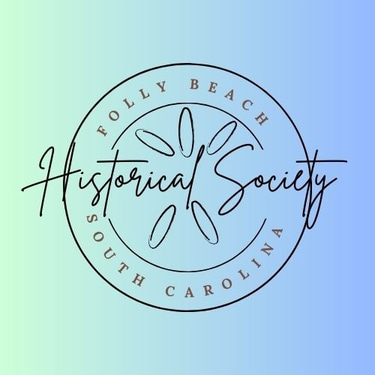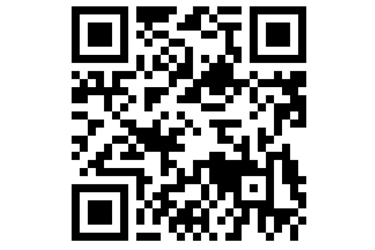Surf Clubs and Contests:
In 1965, a group of men and women organized the first surf club on Folly. Rick Fichtman arrived with a number of embroidered patches that he had obtained as a member of a disbanded club in Miami, so with these patches as their logo, they adopted the name. West Coast East Surf Club. WCE sponsored the first surf contest on Folly in 1966.
Here are a couple of images to help the reader identify the earliest members of the surfing community.
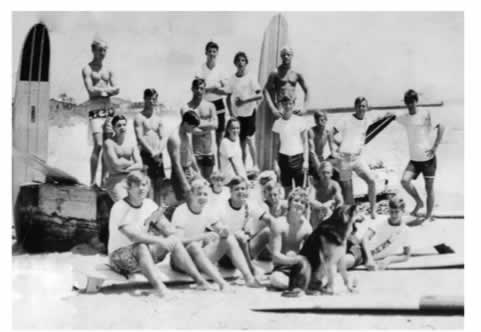

The sport of surfing grew quickly on Folly and in South Carolina. By the beginning of 1969 there was enough regional interest that McKevlin’s Surf shop sponsored its first annual Invitational Surfing Meet on Folly on January 8, 1969. It was held in front of the old Plaza “Pavillion”— an open area which was across the Plaza thoroughfare – an extension of Center Street – from the bumper cars and the entrance to the Folly dance pier. The contest boasted 95 entries willing to brave the 50- degree water with bare skin. Remember that rubber “wet suits” were just a rumor at this time, so surfing in January was partially an endurance sport. The judges for the first event were Florida up and comers Claude Codgen and Bruce Valuzzi.
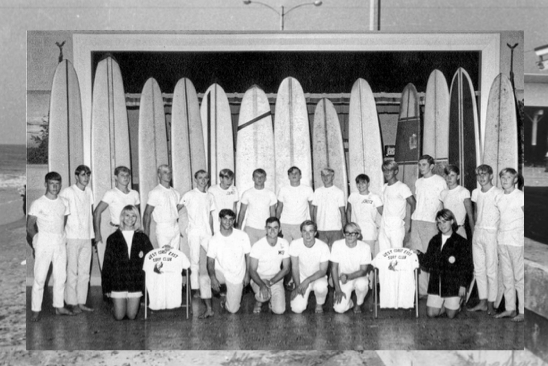

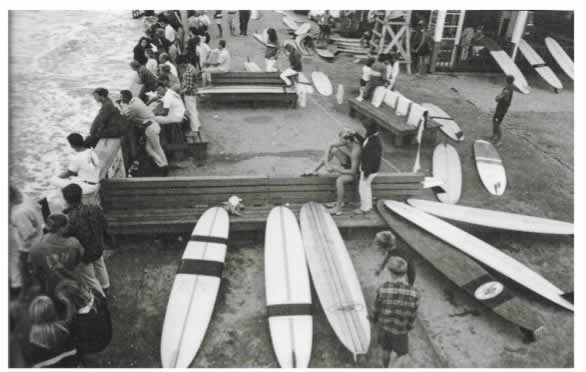

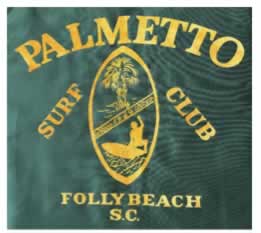

In 1969, as the West Coast East Surf Club was fading, another surf club was organized on Folly, The Palmetto Surf Club. Ted McKevlin was president, Ricky Koger was Vice President and Nanci Polk was Secretary. It lasted about a year and a half, held one contest, and was disbanded due to the poor behavior of a couple of members.
There was on more surf shop on Folly. 39-year-old Folly resident John Kalagian and his wife Susan Bogart bought the Barrier Island Surf Shop from Michael Golemis in late 1989. It was located in what used to be the old Folly Road Toll Booth building at the corner of Sol Legare and Folly Rd. John fractured his neck and was paralyzed in an accident during an April 1986 practice session in his Porche at a Riverside California IMSA GTP event. After about a year they moved to the building the Drop In restaurant now occupies. After John’s death in 1996, Michael bought back from Susan, ran it for about a year and sold it. The new owner moved it back to its original location at the toll booth where it became a surf shop - tackle shop – bar, gradually fading away and closing.
While Michael and John owned the shop, it was influential and successful with an enthusiastic following and a respected surf team.
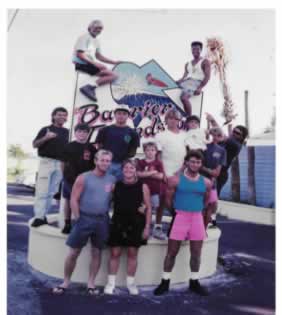

Barrier Island Surf Shop Team
Trouble in Paradise
On June 2, 1965, the Township of Folly Beach passed its first motion limiting where surfing was allowed. In 1972 under city manager Jack Wilbanks, Folly restricted surfing to what we now call the “Washout”. Back then it was the most dangerous place on the beach to surf and was called “The Stumps” because erosion in the area had exposed the pilings of old houses, tree stumps, concrete foundations, and the remains of a road bed from a time when homes once existed there. On good days surfers would be so concentrated in that dangerous area that they could reach out and touch each other.The conflict between the surfers and Folly was being watched locally and nationally as there had been two unsuccessful lawsuits in state court in the surfer’s effort to reverse the restrictions.
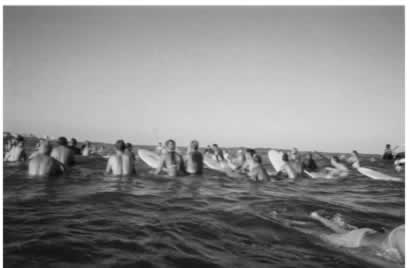

The Washout got a bit crowded credit: Ted McKevlin
The Eastern Surfing Association and Folly:
The Eastern Surfing Association was officially formed in Virginia Beach in 1967 by NJ’s Cecil Lear, CT’s Rudy Huber and CA’s Hoppy Swartz. It has since spread to be the umbrella surfing association for surfing for the entire east coast.
Stephen Fletcher came to Folly from Cocoa Beach, Florida and was frustrated by the surfing community’s inability to regain access to the best surfing spots. He contacted The ESA’s Doc Couture in 1974 and brought the Eastern Surfing Association to Folly. Steve became the first director of the North Carolina, South Carolina division of the ESA. He solicited their help in the conflict with Folly. The end result was that Steve became a plaintiff with Jack Shepard in the 1974 federal civil rights lawsuit brought by Folly Beach resident, attorney O. Benjamin Peeples (ESA V. City of Folly Beach). The lawsuit was settled in 1976 in a summary judgement against the City of Folly Beach. The surfing ordinance that resulted removed the restrictions on where the surfers could surf and incorporated one of the first leash laws on the east coast. Mr. Peeples so impressed the Folly city government that he was hired as city attorney and served in that capacity for 40 years and one day.
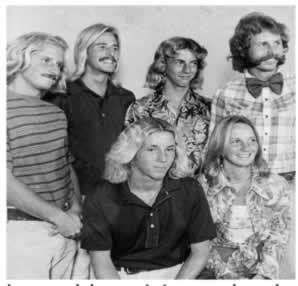

The South Carolina Chapter of the Eastern Surfing Association Team 1974: Front Row: Glenn Tanner, Cathy Walker; Second Row: Donnie Smith, Al Logan, Gregg Elliot, and Steven Fletcher
When the restrictions on where surfing were lifted in 1976, the sport blossomed and became the welcoming and public serving sport that it is today.
In 1995, after the Washout had become the most popular place to surf, the City of Folly Beach, under Mayor Bob Linville, attempted to eliminate surfing at the washout by resurrecting SEC. 7-3-1 of a 1966 law that somehow still remained on the books. Local surfers united under the guidance of an ad hoc committee of the Southern South Carolina District of the Eastern Surfing Association consisting of Angie Youngblood, Bill Perry, Tommy Bolus, Ed Boudolf, John Kalagian, Betty Sue Cowsert, John Crumrine, Casimir (Joey) Kowalski, Jimmy Howe, Tim McKevlin, Philip “pep” Przyborowski, Glenn Tanner, Craig Simms and Bill Youngblood reminded city council that surfers would vigorously defend their rights. City Attorney Ben Peeples assured city council that enforcement of the 1966 law would lead to an unwinnable and likely costly lawsuit because of the loss that the city suffered in the 1976 federal civil rights lawsuit, Eastern Surfing Association v. City of Folly Beach. When the city council fully assessed reality, it simply dropped the effort to limit surfing at the Washout.
Mention needs to be given to two Folly Surfers that have passed away while surfing. Willie Wright was a well-loved and respected surfer who died while in the water. He was rushed to shore but could not be revived. Hank Bauer, a teacher and devoted surfer, stopped as he walked out of the water, looked up at the sky, smiled, and suffered a fatal heart attack.
Summary:
Over the intervening years, surfing has become an indelible part of the character, identity, and economy of Folly. Folly’s cultural identity and surfing cannot be separated.
The people who grew up surfing on Folly have surfed across the globe and while the name Folly Beach may not be well known, Folly surfers have a reputation for having a distinctively fluid style, born – no doubt – in the skills that are needed to read and ride the particular ocean waves that bless this beloved barrier island at the edge of America.
We hope this exhibit give will both give you a better insight into the history of surfing on Folly and introduce you to the people responsible for its growth as a sport and as a means of serving the larger community.
The number of people that have been a part of the sport on Folly since the sixty years since its beginning is so large that a comprehensive summary of their individual achievements is not possible in the scope of this document, but as individuals of note are identified, it will be easy for us to add their profiles to our electronic data base.
That being said, we think it is important to give the reader some highlights that show not only individual achievement but also the impact of the public service organizations that have grown out of this community’s love of surfing. More information on each of these and many other people that were or are important to surfing can be found on our information kiosk
Individuals and organizations of note:
· Pat Thomas:
Pat was one of the first people who took a serious interest in surfing on Folly and certainly the first woman on Folly to own a surfboard (a Corky Surf Board manufactured on Folly Road). A Folly resident, she was very much a part of the enthusiasm of the earliest days of surfing on Folly. Pat only surfed a year before graduating from high school and going to college.
· Nanci Polk Weckhorst:
Nanci was from West Ashley but her grandmother had a house on East 12th Street. She learned to drive in the rutted dirt roads of East 6th Street and got her first taste of surfing on her grandmother’s wooden ironing board. Nanci was the first female professional surfer from Folly. Nanci was a member of practically every Folly surf club. She breezed through all the surfing categories. Nanci went on to tie for 1st. in the Eastern Surfing Association nationals in Hatteras in 1972 and 2nd in one of the first professional contests ever held on the East Coast. Selected to an alternate spot in the World Contest that same year Nanci was the first pro surfer to come out of South Carolina – male or female.
· Glenn Tanner:
Glenn was there at the beginning and like Nanci was a tremendously talented surfer. Glenn is revered by all who know him for his generous and modest spirit. Glenn has mentored many a young surfer. His many personal achievements in surfing can only be appreciated by reviewing his bio in the electronic kiosk. He credits Donny Smith with getting him started with his inclusion on the Wave Machine team. After forty-seven years of amateur competitive surfing, Glenn holds a US Championship title, 12 East Coast Championship titles (8 shortboard, 4 longboard), and an East Coast Iron Man title (up against the skillful Billy Curry). "I've always enjoyed the camaraderie of going up to the Easterns every year and spending time with fellow surfers who share my passion, coming from small beach towns just like me. Glenn has been nominated to be in the East Coast Surfing Hall of Fame It’s a huge honor. “I am humbled.", expressed Glenn.
· Terri Tanner:
A veritable dynamic duo, Terri and Glenn have shared their love for surfing and competing. They met in a near collision while surfing opposite directions on a wave in the early 1980s and were married on Folly. Terri is a SC State Champion and the only South Carolinian to have won the coveted Highest Score at the Easterns. She has also won the Mid- Atlantic Regional Championship, the Eastern Surf Championship, and was the Hot Wave winner of the 1992 Easterns.
· Donny Smith:
Donny and his mom ran the Wave Machine Surf Shop on Folly. Donny is often cited as a mentor for the surfers on his team. He won the 1974 S.C. State Championship. Donny is said to have chosen surfers for his teams that he thought had the greatest potential not the most obvious talent. He really enjoyed teaching young surfers to develop their own style and grace.
· Bill Perry and Bettie Sue Cowsert:
Neither Bill nor Bettie Sue is long on conversation, so this will be a summation of what I have learned through recent conversations with Bill. Bill and Bettie Sue spend most of their time in the Bahamas since they sold the Ocean Surf Shop in 1984, but Bill tells me that he and Bettie Sue are grateful for all the good times and good people that were part of his life here at Folly. Both were very active in the surfing community while they lived on Folly. They will forever be remembered for creating the moniker that identifies Folly as “The Edge of America"
· Ricky Koger:
Ricky opened his first surf shop in 1977 in what used to be the old Bingo Parlor (Bounty bar). In 1978 he then moved into the space that Dewey’s Surf Shop had occupied and ran the shop for four years until he left to join the Charleston Fire Department. Ricky was one two surfers arrested for surfing outside of the areas that surfers were allowed to surf in. Those arrests were the basis for the first two unsuccessful lawsuits to overturn the restrictions that the City of Folly Beach had imposed on surfers 1n 1972. Those lawsuits were the beginning of a legal process that would eventually remove the restrictions from surfing.
· Stephen Fletcher:
Steve brought the Eastern Surfing Association to Folly. He became its head and promoted organized surfing through movies and contest. He later went on to become one of the two plaintiffs in the federal civil rights lawsuit brought by attorney Ben Peeples that removed the restrictions on surfers that had been imposed by the City of Folly Beach between 1965 and 1972.
· Lilla and Foster Folsom:
Foster was there from the very beginning of surfing at Folly in 1963 and still surfs on a daily basis. As I set out to write these stories, I found that Foster and Lilla are more or less the repository for the connections between the members of the surfing community and surfing at Folly. In 2016 they wrote Surfing in South Carolina (ISBN 978-1-4671-1513-1). Writing this story about the connection of this town to the sport of surfing would have been impossible without their contacts and the trust that the surfing community puts in them.
· Dewey (David) Mauldin:
Dewey’s Mom and dad, Jane and Jack Mauldin, opened and ran Dewey’s Surf Shop. They not only sold surf boards and sponsored teams, but also helped to create the first cohesiveness of the surfing community. Jane Mauldin was known as the “Mother” of Surfing on Folly for all of the care and support she showed the young surfers of the day. Dewey went on to have a decorated career in the Marines and as an executive at Boeing Aircraft.
· Katie Coryel and Kelly Kane:
Katie and Kelly were two of the ten female surfers from Folly that visited the East Coast Wahine contest in Wilmington in 2000. They were members of John Kalagian’s Barrier Islands Surf team. They became roommates in 2001 and decided that Folly should have its own contest that not only highlighted and promoted the skills of the women in surfing, but would also seek to include more women in the sport they loved so much. They created the first Folly Beach Wanine contest in 2002 and served as its directors for five years. The Folly Wahine contest celebrated its 23rd anniversary at the Washout the 26th and 27th of July, 2025 with Dr. Nicole Elco as its current executive director. There were over 250 entries from multiple states at the recent meet. See nicole@follywahine.com for more information
· Gregg Elliot:
Greg Elliott is a legendary figure in the Charleston surf scene whose influence reaches far beyond Folly Beach. A professional surfer in the 1980s, Greg chased swells across the globe, competing and carving his name into the fabric of East Coast surfing during one of its most defining eras.
In the years that followed, Greg channeled his passion into entrepreneurship—founding the G-Force Surfboards brand, known for its quality craftsmanship and performance shapes. He also owned and operated multiple surf shops in Charleston, S.C. in the 1990s and early 2000s, supporting local surf culture and shaping generations of riders.
· Kyle Busey:
Katie Coryel remembers Kyle as a “grom” (child) surfer back in the late 1990s. Kyle would go on to be the latest surfer to come out of Folly who would gain professional status. He turned pro in 2004.
Kyle is arguably the best surfer to ever emerge from SC. He was born and raised right here in Charleston. He started to surf at age 11 and by age 14 was National Champion. After winning multiple state, regional, and East Coast titles, he became a professional surfer. His accomplishments include 2000 National Champion, 9X State Champion, 2000 Surfer of the Year, 2001 Regional and East Coast Champion, 2014 Regional Champion, 2014 East Coast Champion and 2016 State Champion. He serves as a stunt consultant for the Netflix series Outer Banks and has created Carolina Salt to share his passion with Charleston through teaching. www.carolinasalt.surf. To see a video of Kyle in action, please watch this clip.
· Warrior Surf:
Started by Andy Manzi in 2015, Warrior Surf is dedicated to introducing veterans to surfing and in assisting them in navigating life after their service.
Andy started his organization by giving instructions to a few veterans in front of the Tides at folly Beach. In 2018, Andy received CNN’s Hero of the Year award in recognition for the impact he has had on the veteran community. Interestingly, it is the sale of surfboards donated and signed by Jimmy Buffet that gave the fledgling organization the financial boost it needed to expand and build its footprint. With Clayton Merrit as its current executive director, Warriors Surf continues to inspire and support our veterans. www.info@warriorsurf.org
· Surfers Healing:
Surfers Healing is an organization that is dedicated to improving the lives of children with Autism through exposure to the sport of surfing. Our chapter is part of a nationwide organization that hold events to bring the dimension of surfing to these children. Nancy Hussey has served in many roles in support of the surfing community over the years, and currently serves as the executive director of Surfers Healing. More information can be found at www.surfershealing.org or can be reached directly at Surfershealingfolly@gmail.com
· Charleston Surf Rider Foundation:
“The Surfrider Foundation is dedicated to the protection and enjoyment, waves, of the world’s oceans, waves, and beaches, for all people through a powerful activist network”. Zach Watkin is the current chair. For more information, visit www.charleston.surfrider.org.
· Waves 4 Women:
Waves 4 Women is a program that serves teens, young girls and the under served children of our area by partnering with Meeting Street Academy organization called Horizons at Ashley Hall. They also partner with a program called Mad Park all with the intention of breaking down the barriers that keep children from accessing the ocean. For more information, please see www.waves4women.org
The beautiful part of the way we are capturing this history electronically is that it can be expanded as time passes. If you think we have failed to cover something, we hope you will bring it to our attention. The Folly Beach Historical Society is dedicated to preserving the history of this unique and lovable island.
Richard L. Beck

Kyle Busey
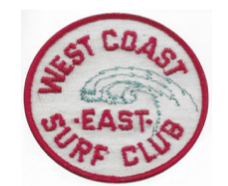

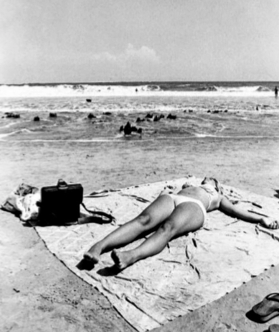

1st West Coast East Surf Club 1965. Members include, from left to right (front row) Brenda Tucker, Rick Fichtman, Mike Taylor, Greg Nutt, Randy Nutt and Kim Nutt, (second row) Chip Yarnell, Mike Jenks, George Steel, Ronnie Shepperd, Frank Davis, Rusty Schwartz, Steve Means, Greg Holliday, Jack Tripp, Bob “Chico” Pachico, Jim Humphries, Allen Barnett, Foster Folsom, Dewey Mauldin, and Danny McMillan
(courtesy Frank Davis)
Impromptu gathering of the West Coast East Surf Club in 1966: from left to right (front row) George Steele and Chief the dog; (second row) Terry Hennett, Ted McKevlin, Greg Holiday, Dave Hebden, Hubert Jones, and Dewey Mauldin (reclining); (third row), Bob “Chico” Pachico, Tom Craft, Mikey Knight, Kim Nutt, Jackie Peters, Eddie Benton, Bugsy Chevier, Jim Humphries; (fourth row) Jack Tripp, John McDonald, Rick Fichtman, Ed Andrews, Dean Monk, and Ronnie Shepperd (Courtesy Dean Monk)


January 8, 1969 McKevlin Invitational Surf Meet
Another View of the 1969 McKevlin Meet
The Palmetto Surf Club 1969
The Washout With Stumps, 1972
credit: Richard Green
